Aloe polyphylla is a rare and fascinating succulent that has captured the attention of many gardeners around the world. It’s an endemic species native to Lesotho in South Africa, where it grows naturally on rocky slopes at high altitudes. In this article, I’m going to share all you need to know about this unique plant so you can decide if it’s right for your garden!
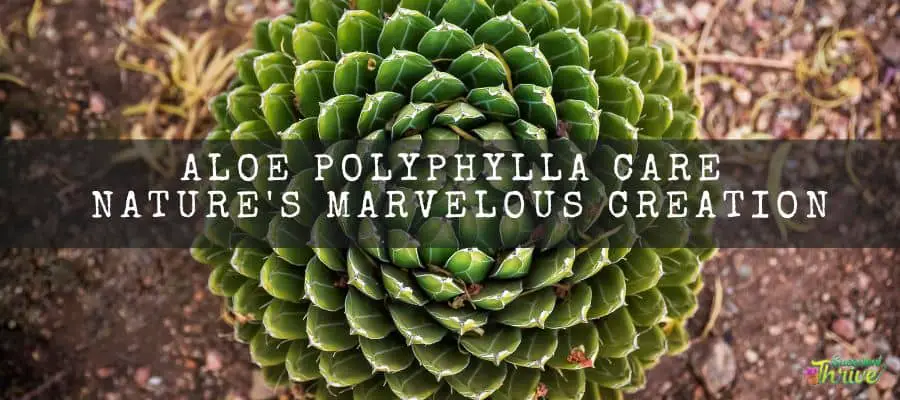
The rosette form of Aloe polyphylla presents itself as a perfect spiral, which is why it’s often referred to as ‘spiral aloe’. The leaves are thick and fleshy with sharp tips and grow up to 30 cm long. As the plant matures, its shape becomes more pronounced and beautiful. Its bright green color stands out from other plants in any landscape setting.
Aloe polyphylla requires specialized care due to its rarity and sensitivity to climate conditions. If you’re looking for something truly special that will add character and interest to your outdoor space, then this could be just what you’ve been searching for!
One look care guide
| Botanical Name | Aloe polyphylla |
| Common Name | Spiral aloe |
| Plant Type | Succulent |
| Mature Size | Leaves can grow up to 12 inches (30 cm) long and 2 inches (5 cm) wide |
| Sun Exposure | Partial sunlight |
| Soil Type | One part loam one part sand one part peat moss or coco coir |
| Soil pH | Around 6.0 – 6.5 |
| Bloom Time | Early summer |
| Flower Color | Pale pink or yellowish white |
| Hardiness Zones | USDA Zones 10-12 |
| Native Area | South Africa |
| Toxicity | Toxic |
| Average price | USD 15.99 |
What Is Aloe Polyphylla?
I’m sure you’ve seen Aloe polyphylla, the spiral aloe from South Africa. It’s an incredibly unique and beautiful succulent plant that has become increasingly popular in recent years. The leaves of this impressive specimen are arranged in a perfect spiral pattern around its center, often with five (or sometimes seven) rows of thick green foliage radiating outward like petals on a flower.
Aloe polyphylla is drought tolerant and easy to care for, which makes it ideal for those who don’t have much gardening experience or time to devote to their plants. While it does require some attention during the growing season, such as watering once every two weeks and occasional fertilizing, overall upkeep isn’t too difficult. With proper care, this stunning aloe can live up to several decades!
Its gorgeous appearance combined with its hardiness make Aloe polyphylla a great addition to any garden or home decor scheme. Whether your style is modern minimalism or colorful boho chic, this exquisite succulent will be right at home wherever you choose to display it. Plus, knowing that these frost-sensitive beauties thrive in warm climates means they’ll also bring life into your outdoor space – now that’s what I call win-win!
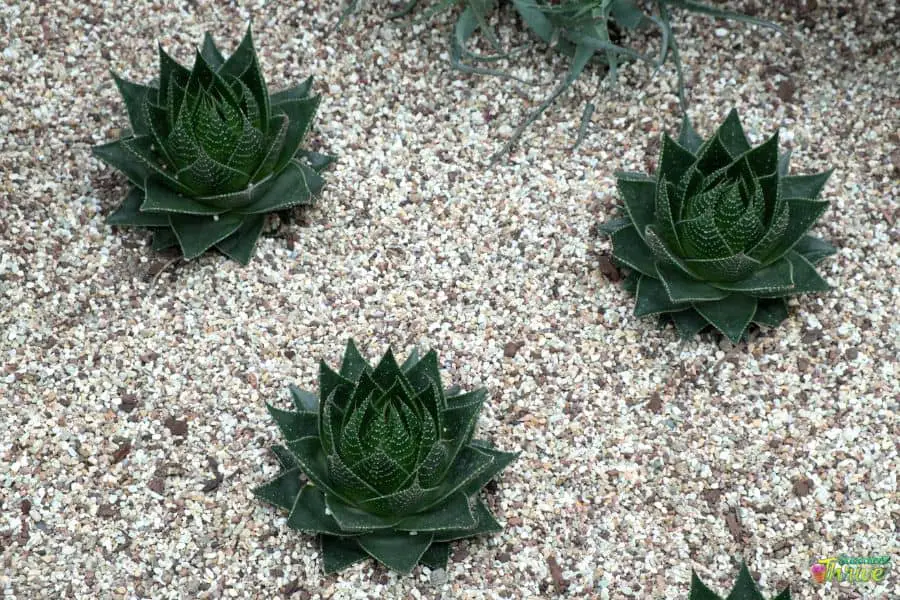
How Do I Identify Aloe Polyphylla
Identifying Aloe polyphylla is not difficult. It’s an iconic aloe species with a unique spiral shape, and its care is relatively easy too. Here are the main characteristics of this plant that you can use to identify it:
1. Its unique rosette form – The Rosette of Aloe polyphylla typically grows in a symmetrical pattern which forms a perfect spiral from the center outward.
2. Its thick pointed leaves – This species has thick succulent leaves that grow outwards in alternating directions and end in sharp points.
3. Its vibrant red foliage – Due to its special adaptation for high altitudes, Aloe polyphylla produces deep red or orange foliage when exposed to direct sunlight.
4. Its yellow flowers – During the blooming season, the tips of each leaf on the plant will produce bright yellow flowers that last about two weeks before wilting away.
Size of the plant:
The size of Aloe polyphylla can vary depending on its growing conditions, but a mature plant can have up to 150 leaves arranged in a spiral pattern.
The leaves can grow up to 12 inches (30 cm) long and 2 inches (5 cm) wide.
Growth rate:
Aloe polyphylla is a slow-growing plant, but its growth rate can be increased with optimal growing conditions such as good soil, proper watering, and adequate light.
In ideal conditions, it can grow up to 2-3 inches (5-8 cm) per year.
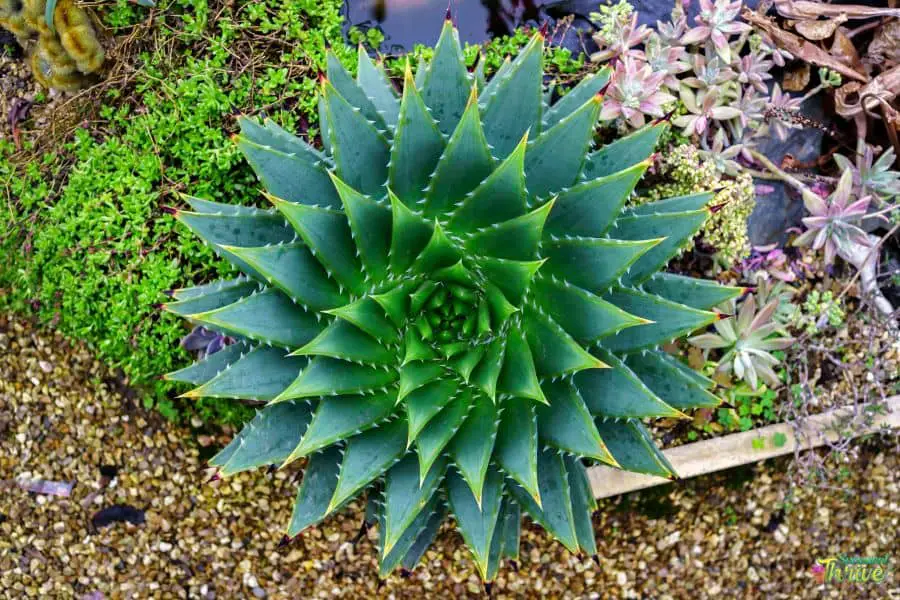
How Do You Take Care Of The Aloe Polyphylla
Taking care of the Aloe polyphylla is not difficult, but it does require some attention. First and foremost, its soil should be kept moist at all times. It needs to be watered regularly with a generous amount of water that will allow for drainage. Additionally, when watering, make sure not to oversaturate the pot or root rot could occur.
The next important step in caring for this plant is keeping an eye on its temperature. Aloe polyphylla prefers slightly cooler temperatures than most other succulents, so if you live in a warmer climate, make sure your plant gets enough shade throughout the day. Also keep in mind that during colder months, they may need more protection from frost and chill winds – so providing them with extra insulation can help ensure their safety.
Finally, fertilizing twice per year (spring and summer) will give your Aloe Polyphylla the nutrients it needs to stay healthy and vibrant. Make sure to use a fertilizer specifically designed for cacti and succulents as they have different requirements than other plants! With these simple steps, you’ll be able to enjoy beautiful blooms every season without any hassle!
Light Requirement
Aloe polyphylla thrives in sunny, warm climates. It’s best grown outdoors and requires at least four hours of direct sunlight per day. If planted indoors, it should be placed near a south-facing window that allows plenty of natural light to reach the plant.
Temperature And Humidity
First of all, this plant loves warm temperatures. It should be kept between 60-80°F (15-26°C), with an ideal range being 68-74°F (20-24°C). Anything above 80°F will make it stressed out and cause its leaves to become discolored or even fall off. On the other hand, if temperatures drop below 50°F (10°C) for too long then you’ll risk killing your beloved Aloe polyphylla.
In addition to temperature, relative humidity also plays a huge role in keeping your aloe happy and healthy. For best results, aim for somewhere between 40% – 70%. Higher than 70% can lead to fungal diseases while anything lower than 40% can cause dehydration in the plant’s leaves. To keep these numbers up during drier times I recommend misting around twice daily. This will help increase moisture without overdoing it on waterings — something succulents are very sensitive to!
Watering Requirement
Watering Aloe polyphylla is a critical part of keeping it healthy. It needs to be watered regularly, but not too frequently or else the plant can suffer from root rot. A good rule of thumb is to wait until the soil has dried out before watering again. This usually takes about two weeks in the summer and up to four weeks in winter.
It’s important to water deeply so that the entire root system is moistened. Water slowly at the base of the plant using a hose or a watering can with a long spout for accuracy. Make sure you don’t get any water on the leaves as this could cause sunburn or damage them otherwise. Too much water will also cause problems, so always check your soil moisture levels before deciding whether or not to water your Aloe polyphylla plants.
Soil Requirement Type / Ph
This succulent is quite particular when it comes to soil type and pH level. It prefers well-draining soils with a slightly acidic pH of around 6.0 – 6.5. The ideal mix would be one part loam, one part sand, and one part peat moss or coco coir. Furthermore, consider adding some pumice or perlite to create an even better drainage system so that the roots won’t become waterlogged. If you can’t find these ingredients readily available in your area, there are plenty of cacti and succulent potting mixes available as well.
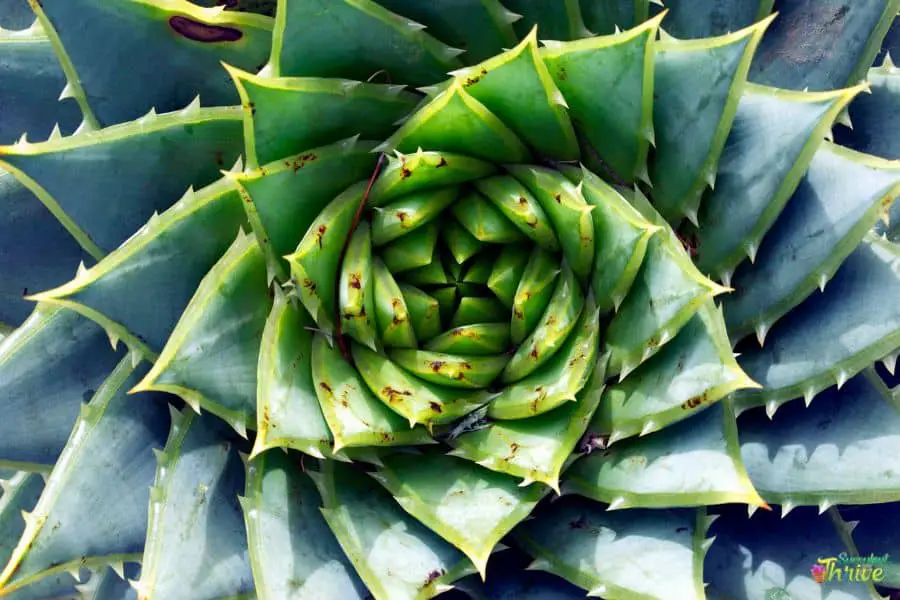
Pot Size Potting And Repotting
When it comes to pot size for the Aloe polyphylla plant, you want to make sure that it is large enough to accommodate its root system. A good rule of thumb is to select a pot that’s two inches wider than the circumference of your existing aloe plant. Additionally, be sure to use a container with drainage holes at the bottom so excess water can escape.
For potting and repotting an Aloe polyphylla, here are some helpful tips:
- Soil: Select a soil mixture specifically designed for succulents and cacti as this type of soil will allow ample drainage while also providing necessary nutrients to ensure proper growth.
- Fertilizer: Use a balanced fertilizer every few months during growing season in order to provide essential minerals needed by the plant.
- Timing: Repotting should take place when temperatures are mild and before springtime when plants begin actively growing again.
Flower
Its flowers are delicate and bell-shaped, typically pale pink or yellowish white in color. They bloom from late spring until early summer on tall stalks that reach up to 6 feet high. Each flower is made up of six petals and has a sweet fragrance that can be detected for miles around.
In addition to its beautiful appearance, this plant also serves as an important part of its natural ecosystem by providing food for insects such as bees and butterflies.
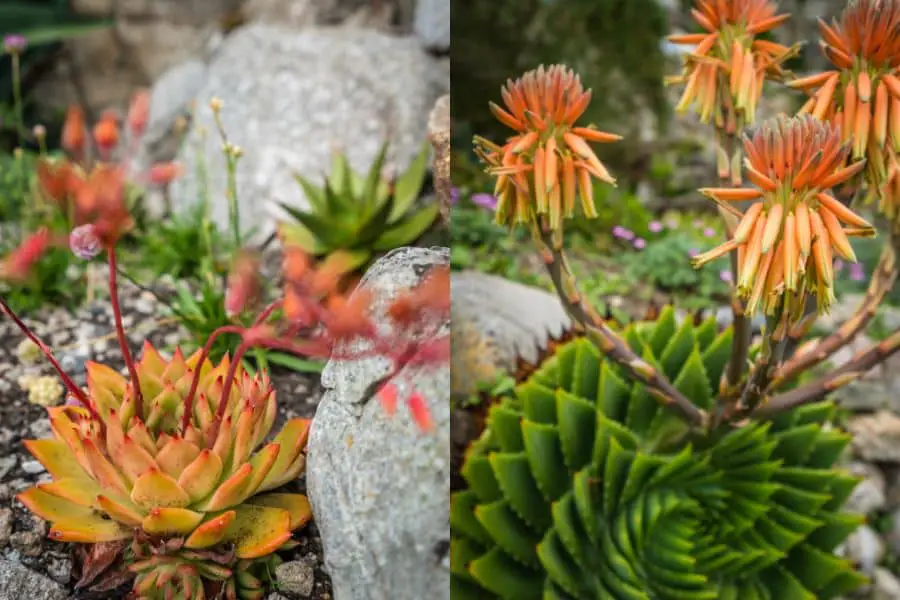
Common Bugs And Illnesses
The most common pest affecting this species are mealybugs, which suck out juices from leaves and stems. These small white insects live in clusters and create a sticky substance called honeydew as they feed. To get rid of them, you need to apply insecticidal soap or neem oil directly onto their colonies.
Another problem for Aloe polyphylla plants is root rot caused by overwatering or poor drainage. The roots become saturated with water and start decaying, resulting in yellowed and wilted foliage. To prevent it, avoid watering too frequently and make sure your soil has excellent drainage qualities. If caught early enough, the plant can still recover if given proper care and nutrition.
In order to keep your Aloe polyphylla healthy, it’s best to monitor it regularly for any signs of pests or diseases; then act quickly before they cause irreparable damage!
Hardiness Zone
Aloe polyphylla is an evergreen perennial plant native to the Lesotho highlands of South Africa. It’s hardy in USDA Zones 10-12, but may die back during a severe winter season. In these regions it needs full sun and excellent drainage. If grown in colder climates, Aloe polyphylla must be protected from frost with extra insulation or moved indoors for the winter months when temperatures dip below freezing.
Is It Cold Hardy?
Aloe polyphylla is an incredibly hardy plant and can withstand temperatures as low as -4°C. This makes it perfect for growing in areas where there are cold winters, but also hot summers. It does require a certain level of protection from the wind during freezing temperatures however, so make sure to provide some sort of cover if you live in an area with extreme winter conditions.
To ensure its survival through colder months when growth slows down significantly, be sure to give your plant enough water before winter arrives.
Dormancy
Aloe polyphylla is a winter-dormant plant and may lose its leaves during this time. It’s important to reduce watering and avoid fertilizing during the dormancy period. The plant will come back to life in the spring, and new leaves will start to grow.
Toxicity
Aloe polyphylla is toxic to humans or pets. The gel inside the leaves can cause skin irritation in some people, so it’s important to handle the plant with care.
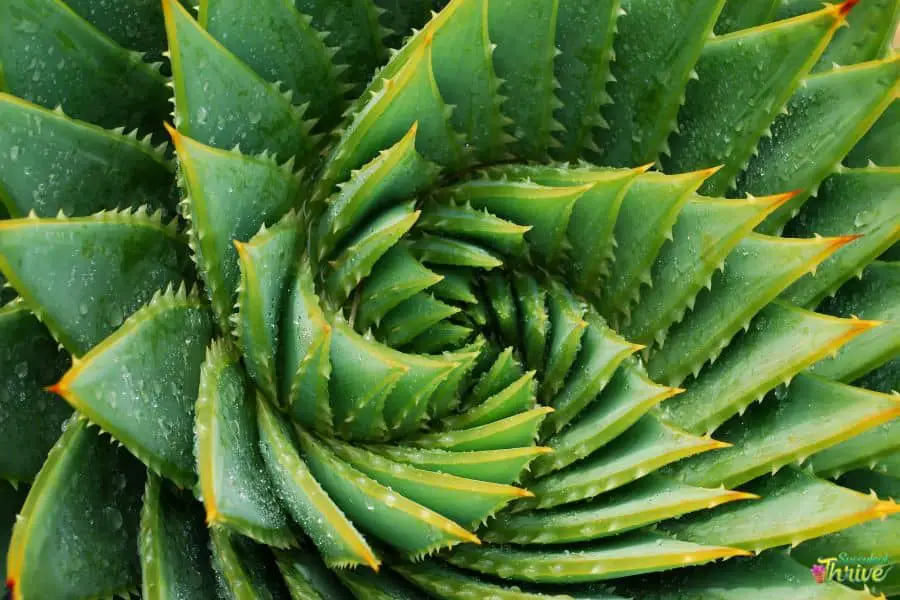
How To Propagate Aloe Polyphylla
Now that you’ve taken care of your Aloe polyphylla, let’s learn how to propagate it. Propagating this succulent is easy and fun! Here’s what you need to do:
- Start by selecting a healthy leaf from the parent plant. This should be done carefully as not to damage the rest of the leaves or stem.
- Cut off the selected leaf with a sharp knife or scissors just below where it meets the stem.
- The cut end must dry for several days until it forms a callous over the wound; otherwise, it may rot when placed in soil propagation medium.
- Put your cutting into well-draining soil with some perlite mixed in, if available. Place pot near indirect light – direct sunlight can burn delicate leaves.
- Water sparingly – no more than once every two weeks – make sure soil dries out between watering sessions.
Your propagated Aloe polyphylla will now start forming roots within 2–3 months and new leaves shortly thereafter. With proper care, you’ll soon have an entire collection of aloes ready for harvesting their medicinal uses!
Aloe Polyphylla Benefits
Aloe polyphylla used in african tribal medicine and magic
Conclusion
In conclusion, Aloe polyphylla is a unique and interesting plant to own. Not only does it look great in any garden, but its benefits make caring for it worthwhile. It’s not the most common succulent out there, so if you manage to get your hands on one of these beauties, taking proper care of it will ensure it stays healthy and happy for years to come. With a little bit of attention and knowledge about how best to propagate this aloe species, you’ll be able to enjoy its beauty without too much effort. Plus, with its cold-hardiness levels, you don’t have to worry about bringing it inside when temperatures drop. I’m sure that once you learn more about this special plant, you won’t be able to resist adding an Aloe polyphylla into your collection!
Read Next : Aloe Marlothii Or Mountain Aloe Useful Care Tips
